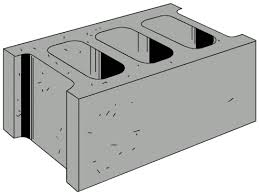Concrete Blocks
(1) Raw materials used in Concrete Blocks :
The materials required for the production of the concrete blocks are aggregates, cement and water. The aggregates of various types have been used with varying degree of success and they include crushed stones, gravel, volcanic cinders, foamed slag, furnace clinker, etc. The aggregates are selected by considering the weight, texture or composition of the unit designed. The strength, texture and economy of the concrete block depend upon the careful grading of the aggregate. If locally available aggregate is suitable, it will help in achieving the economy. The cement used is ordinary Portland cement. The water required is the normal potable water.
(2) Manufacturing of concrete blocks:
The fully automatic plants are available for the manufacture of high strength concrete blocks. These automatic machines produce superior quality concrete blocks. But they involve a large capital investment. The manually operate machines are also available and they can be installed at project site itself which further reduce the transportation cost of the concrete blocks from the place of production to the place of actual use.
The processes involved in the manufacturing of the concrete blocks are as follows:
(i) Selection and proportion of ingredients: The main criteria for the selection of the ingredients is the desired strength of the block. The greater the proportion of coarse aggregate, the greater will be the strength of the quantity of cement used.
(ii) Mixing of ingredients: The blending of aggregates, cement and water should be done very carefully. The mixing should preferably take place in mechanical mixer. For hand mixing of concrete, extreme care should be taken to see that the cement and aggregates are first mixed thoroughly in dry state and the water is then added gradually.
(iii) Placing and vibration: The mixed concrete material is fed into the mould box up to the top level and it is ensured that the box is evenly filled. The vibration of concrete is done till it has uniformly settled in the mould box.
(iv) Curing: The block is watered after about one day of casting and it is continued for a minimum of 7 days and preferably till 28 days. The longer the curing period, the better will be the block.
(3) Advantages of concrete blocks:
The use of concrete blocks as a masonry unit can be observed on many construction sites because of the following advantages:
- It increases the carpet area of the building because of small width of concrete block as compared to the brick masonry wall.
- It provides better thermal insulation, enhanced fire resistance and sound absorption.
- It results in the saving of precious agricultural land which is used for the manufacture of bricks.
- The blocks can be prepared in such a manner that the vertical joints can be staggered automatically and thus the skilled supervision is reduced.
- The construction of concrete block masonry is easier, faster and stronger than the brick masonry.
- The perfect shape and size of the concrete block makes the work of a mason much simpler.
- There is saving in construction of mortar because the numbers of joints are reduced.
- The utility can be further increased by producing the reinforced concrete block (RCB) masonry units. The blocks are provided two holes for placing suitable reinforcing bars and the structure with RCB units could safely resist wind and earthquakes, if so designed. The traditional beams and columns can be completely eliminated and the structure with RCB units can be given a better appearance.
(4) Uses of concrete blocks:
In view of the advantages mentioned above, the concrete block masonry technique of construction can be adopted on a large scale for mass housing and various civil engineering projects.

